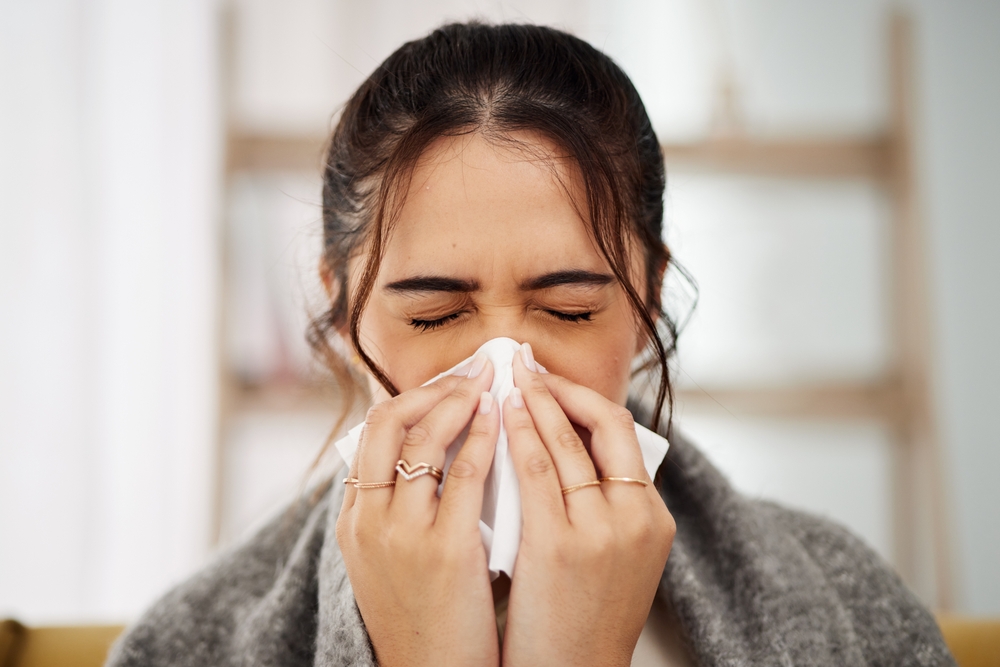A Guide to Allergic Rhinitis

Allergic rhinitis or hay fever can make daily life difficult with symptoms such as sneezing, congestion, runny nose, and itching. Effective self-care is essential to manage these symptoms and enhance your well-being. In this guide, we highlight some practical self-care strategies for allergic rhinitis and provide an overview of the condition, its symptoms, diagnosis, and treatment options.
With over 45 years experience of allergy testing in Sydney, we share our best self-care advice to help manage your condition effectively and improve your quality of life.
What is Allergic Rhinitis (Hay Fever)?
Allergic rhinitis, or hay fever, is an allergic reaction that occurs when your immune system overreacts to airborne allergens.
These allergens can include pollen, dust mite, mould, and pet hair. When you inhale these allergens, that you are sensitised to your body releases chemicals such as histamine, which causes an inflammatory reaction and symptoms in the nose, throat, and eyes.
Common Allergic Rhinitis Symptoms
Symptoms can range from minor to more increased reactions and can differ in intensity. These symptoms, which are brought on by allergens like pollen, dust, or pet dander, frequently resemble those of a normal cold. Sneezing, coughing, postnasal drip, itchy eyes, nose, or throat, watery eyes, and lethargy are typical symptoms. It can be helpful to identify these symptoms in order to successfully manage and cure allergic rhinitis.
The symptoms of allergic rhinitis can vary in severity and may include:
- Sneezing
- Runny, blocked or stuffy nose
- Itchy eyes, nose, or throat
- Watery eyes
- Postnasal drip
- Coughing
- Fatigue
What are the Stages of Allergic Rhinitis?
Allergic Rhinitis can be divided into four stages.
1. Sensitisation:
This stage occurs during the first encounter with an allergen when it initially interacts with the immune system. During this process, the immune system begins to produce specific IgE antibodies targeting the allergen. IgE antibodies are designed in part to protect us against parasites but in the modern world can react to harmless environmental substances
2. Immediate Early-Phase Response:
Following sensitisation subsequent exposure to the allergen, the IgE antibodies which are bound to histimine containing cells become activated. This activation triggers the release of histamine and other similar chemicals, leading to rapid onset symptoms such as sneezing and itching.
3. Late-Phase Response:
This stage occurs several hours after the initial reaction and is marked by a more prolonged inflammatory response. The symptoms during this stage include nasal congestion and postnasal drip, resulting from a sustained immune reaction. For example, this might be when someone experiences persistent stuffiness or a runny nose even after the immediate symptoms have subsided.
4. Chronic Inflammation:
With continued exposure to the allergen, it can become chronic. This stage leads to persistent symptoms, and over time, these symptoms can escalate, potentially developing into more severe issues such as sinus infections. This happens because the body’s immune system is constantly in a state of alert, leading to ongoing inflammation and irritation.
What Are The Causes of Hay Fever?
The cause of allergic rhinitis happens when your immune system overreacts to airborne allergens. These allergens trigger your body’s defence system, thinking they are harmful invaders.
Allergic rhinitis is particularly common in the spring and summer when trees, grasses, and weeds release more pollen into the air. However, it can also be a problem in winter when people spend more time indoors with their pets, and allergens like dust mite and pet dander accumulate in enclosed spaces with closed doors and windows.
Common causes include:
- Pollen: From trees, grasses, and weeds, especially during specific seasons.
- Dust Mite Allergens: Microscopic organisms that thrive in household dust.
- Mould: Spores from mould can be found indoors and outdoors.
- Pet Dander: Proteins found in the skin flakes, saliva, and urine of furry pets.
How is it Diagnosed?
Diagnosing allergic rhinitis typically involves a combination of taking a thorough medical history, physical examination, and allergy testing. Here are the common methods used:
- Skin Prick Test: Small amounts of suspected allergens are introduced into the skin, usually on the forearm or back, to observe for reactions such as redness or swelling.
- Blood Test: Measures the level of specific IgE antibodies in your blood to various allergens. This test can be particularly useful if you have skin conditions or are taking medications that interfere with skin testing.
- Examination of the Nasal mucosa: An anterior rhinoscopy to examine the state of the nasal mucosal area.
What is the Best Treatment for Allergic Rhinitis?
The treatment for allergic rhinitis aims to reduce symptoms and improve quality of life. Here are some effective options you can try:
Avoidance of Allergens:
Identifying and using different types of methods to avoid exposure to allergens can help you maintain your health, especially to those who are more susceptible to allergens.
- Air Purifiers: Using HEPA air purifiers can help filter out pollen, dust mites, and other spores from your home or indoor environment.
- Keeping Windows Closed: During high pollen seasons like spring or summer, keep windows and doors closed to prevent allergens from entering your home.
- Regular Cleaning: Regularly clean your home to reduce dust mite allergens and mould. You should wash clothing and bedding in over 60°C hot water, vacuum carpets and upholstery with a HEPA filter vacuum, and use mould cleaners in damp areas like bathrooms and kitchens to minimise mould allergy risks.
Allergic Rhinitis Medication:
Over the counter and prescription medications can help manage symptoms effectively. These include:
- Antihistamines: Available in both pill and liquid forms, prevent the action of histamine from reacting to the body causing allergic symptoms. Examples include loratadine, cetirizine, and diphenhydramine.
- Decongestants: Help reduce nasal congestion and are available as pills, liquids, and nasal sprays. Examples of this include pseudoephedrine and phenylephrine. Although, nasal sprays should not be used for more than a few days to avoid rebound congestion. If continually used, they can harm the sensitive mucosal area.
- Nasal Corticosteroids: This is highly effective in reducing inflammation and treating nasal symptoms. They are available as prescription and over-the-counter nasal sprays. Examples of this include fluticasone, budesonide, and mometasone.
- Leukotriene Receptor Antagonists: This type of medication is occasionally prescribed by medical practitioners and block the action of leukotrienes, which are chemicals in the immune system that contribute to allergic reactions. Montelukast is a commonly used leukotriene receptor antagonist.
Always follow the guidance of a medical professional when it comes to any type of medication.
Immunotherapy:
This type of treatment involves gradually exposing the body to increasing amounts of the allergen to build tolerance and reduce symptoms over time.
There are two main forms:
- Allergy Shots: Also known as subcutaneous immunotherapy (SCIT), involving regular injections with small amounts of the allergen, typically administered in a doctor’s office. The dosage is gradually increased over time.
- Sublingual Immunotherapy (SLIT): This method involves placing allergen tablets or drops under the tongue, which can be done at home after the initial dose is administered under medical supervision. SLIT is often used for allergens like pollen and dust mite.
You can effectively control allergic rhinitis and significantly improve your quality of life by learning about your individual allergens through testing and utilising these remedies.
Self-care Tips to Manage Allergic Rhinitis
Managing allergic rhinitis can be challenging, but there are several effective strategies you can implement to alleviate your symptoms. Here are some helpful tips to help you manage allergic rhinitis and reduce your exposure to common allergens:
- Avoid Pollen: Stay indoors during peak pollen times, usually in the morning and on windy days.
- Control Dust Mites: Use allergen-proof bed covers, wash bedding in hot water, and reduce humidity in your home.
- Prevent Mould: Fix leaks promptly, use dehumidifiers, and clean mouldy surfaces with appropriate cleaners.
- Manage Pet Dander: Regularly vacuum areas like carpet or any flooring and bathe your pets regularly.
- Keep Indoor Air Clean: Use air purifiers to reduce allergens in your home, keep windows closed during high pollen seasons, and use air conditioning to help maintain clean indoor air.
- Use Protective Gear: Wear sunglasses and a mask when outside to reduce exposure to pollen and other airborne allergens.
- Stay Hydrated: Drink plenty of water to help thin mucus and keep your nasal passages moist.
We hope you find these tips helpful in managing your allergic rhinitis. By incorporating these strategies into your daily routine, you can reduce your exposure to allergens and ease your symptoms. Remember, taking small steps can make a big difference in improving your comfort and well-being.
How Can I Get Tested?
Getting tested for allergies is a straightforward process. At Allergy Testing, we offer comprehensive testing services to identify your specific allergens. If you’re wondering how to get an allergy test, our clinic provides a seamless experience with options like skin prick tests and IgE tests, all conducted in a safe and comfortable environment. Most results are available on the same day, allowing for prompt diagnosis and treatment planning.
Talk to our helpful team, who can guide you through the entire process.

